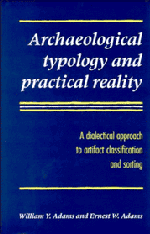 Archaeological Typology and Practical Reality
Archaeological Typology and Practical Reality Book contents
- Frontmatter
- Contents
- List of figures
- List of tables
- The archaeologist's preface
- The philosopher's preface
- PART I Introductory
- PART II The nature of types and typologies
- PART III Typology in action: the Medieval Nubian Pottery Typology
- PART IV Pragmatics of archaeological typology
- 13 The starting point: purpose
- 14 The determinants of types: variables and attributes
- 15 The making of types: formulation, designation and description
- 16 The use of types: typing and sorting
- 17 The ordering of types: taxonomy and seriation
- 18 Variation and variability in archaeological classifications
- 19 The bottom line: practicality
- 20 Principles of practical typology
- 21 Information-theoretic formulations
- PART V Classification, explanation, and theory
- Appendices
- References
- Index
15 - The making of types: formulation, designation and description
Published online by Cambridge University Press: 23 November 2009
- Frontmatter
- Contents
- List of figures
- List of tables
- The archaeologist's preface
- The philosopher's preface
- PART I Introductory
- PART II The nature of types and typologies
- PART III Typology in action: the Medieval Nubian Pottery Typology
- PART IV Pragmatics of archaeological typology
- 13 The starting point: purpose
- 14 The determinants of types: variables and attributes
- 15 The making of types: formulation, designation and description
- 16 The use of types: typing and sorting
- 17 The ordering of types: taxonomy and seriation
- 18 Variation and variability in archaeological classifications
- 19 The bottom line: practicality
- 20 Principles of practical typology
- 21 Information-theoretic formulations
- PART V Classification, explanation, and theory
- Appendices
- References
- Index
Summary
In Part II we talked in somewhat theoretical terms about how type concepts are formulated and communicated. In this chapter we return to the same issues from a more pragmatic perspective, and with reference especially to the relationship between types and attributes.
Discussion in the last two chapters might suggest that typology-making involves a simple and logical progression from the specification of purpose to the selection of attributes to the formulation of types on the basis of selected attributes. This is indeed the procedure recommended in many programmatic statements (Dunnell 1971b: 70–6; Spaulding 1982). Real-life typologies, however, are seldom made entirely in this way or in any single and simple way. The relationship between attributes and types is, in most typologies, a complex and multi-dimensional one.
As we saw in Chapter 5, the formulation and use of type concepts involves a number of successive stages, or processes. Processes that will concern us in the present chapter are those of formulation, definition, designation, and description. We will see that the relationship between attributes and types is somewhat different in each of the four cases, obliging us to make a distinction between diagnostic (prescriptive) and descriptive attributes. In anticipation of the discussion we may say that attributes are prescriptive of types at one level of analysis, and descriptive at another (cf. Whallon and Brown 1982: xvi).
- Type
- Chapter
- Information
- Archaeological Typology and Practical RealityA Dialectical Approach to Artifact Classification and Sorting, pp. 182 - 193Publisher: Cambridge University PressPrint publication year: 1991


